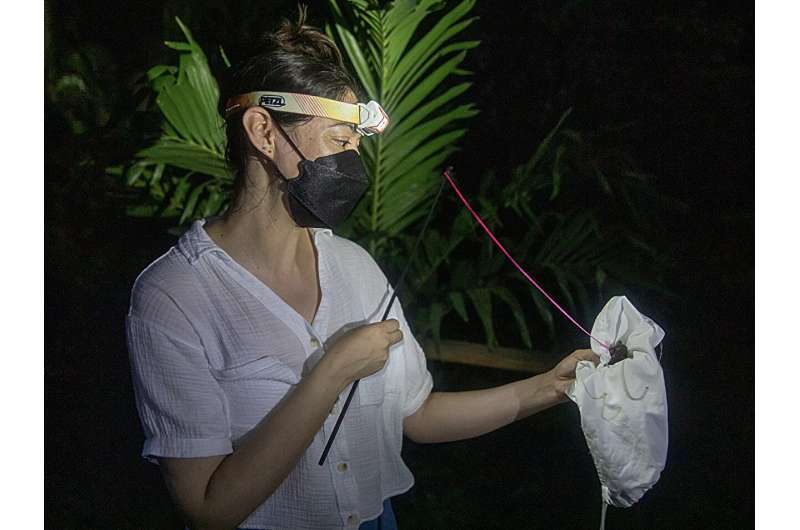Thirty million years ago, the neotropical red-nosed bat survived on a diet of insects alone. Since then, the bat has diversified into many different species by changing its diet. Photo courtesy of the Stowers Institute for Medical Research.
Humans need to regulate blood sugar levels to stay healthy and nourish our cells. Too little or too much blood sugar can cause serious health problems, and hyperglycemia is a hallmark of the metabolic disorder diabetes. New research from the Stowers Institute for Medical Research may look to evolution and bats to find potential solutions to metabolic disorders.
Publication Natural Ecology and EvolutionThe study, led by co-first author Jasmine Camacho, PhD, a postdoctoral researcher, and Andrea Bernal Rivera, a former Stowers Institute researcher in the lab of Dr. Nicholas Rohner at the Stowers Institute, reports the highest naturally occurring blood glucose concentrations ever observed in a mammal, a finding that suggests bats have evolved strategies to survive and thrive by taking advantage of this extreme trait.
“Our study reports the highest blood glucose levels ever observed in nature, levels that would be lethal and coma-inducing for mammals but not for bats,” Camacho said. “We're witnessing a new property that we didn't know was possible.”
Thirty million years ago, the neotropical red-nosed bat survived on an insect-only diet. Since then, this bat has changed its diet and diversified into many different species. Different lineages that descended from insects have specialized diets that include everything from fruit to nectar to meat and everything in between, even blood.
“By looking at animals that have lived for millions of years, we can begin to catalog changes that have occurred over the course of evolution,” Camacho said. “What makes studying the Neotropical red-nosed bats so special is that this group is made up of many different species with diverse diets, allowing us to find answers to how their diets evolved. We hope that we can extend this understanding to other mammals, including humans, so we can learn how to better protect our own health.”
To understand how bats have diversified their diets, the team conducted field research that involved years of travel to the jungles of Central and South America and the Caribbean. The capture-and-release studies focused on glucose tolerance tests, measuring blood sugar levels in about 200 wild-caught bats from 29 species, after they were given a single feeding of one of three types of sugar found in foods such as insects, fruits and nectar.
“We looked at the different ways sugars are absorbed, stored and used in the body and how this process is specialized by different diets,” Bernal Rivera said.
The mechanism that keeps blood sugar levels within a narrow, healthy range is called glucose homeostasis, and is normally controlled by the hormone insulin, but in diabetes this goes awry. Different bat species show different adaptations to glucose homeostasis, from changes in gut anatomy to genetic mutations in proteins that transport sugar from the blood to cells.

“By looking at animals that have been around for millions of years, we can begin to catalog the changes that have occurred over the course of evolution,” Camacho said. Photo courtesy of the Stowers Institute for Medical Research
“Fruit bats have modified the insulin signaling pathway to lower blood sugar levels,” Camacho said, “while nectar bats can tolerate high blood sugar levels, similar to those seen in people with uncontrolled diabetes. They have evolved a different mechanism and do not appear to rely on insulin.”
Although it is still under investigation how nectar bats manage glucose, the researchers have found what may provide clues to alternative metabolic strategies for glucose regulation. Bats with a high sugar diet were observed to have longer intestines and a larger surface area of intestinal cells that absorb nutrients from food compared to bats with other diets. Moreover, unlike fruit bats, nectar bats continuously express genes responsible for sugar transport, a trait also found in some hummingbirds.
“This study establishes a vital resource for the field,” said Nadav Ahitov, PhD, professor of bioengineering and genetics at the University of California, San Francisco. “It provides not only metabolic signatures of different bat species with different diets, but also differences in gut morphology, and candidate genomic regions and protein structures that may drive dietary adaptations.”
“This dataset will facilitate future studies aimed at distinguishing differences in mammalian diets and may advance the development of new therapeutics for various metabolic diseases in humans,” Ahitov said.
More information:
Sugar assimilation underlies the evolution of diet in Neotropical bats Natural Ecology and Evolution (2024). DOI: 10.1038/s41559-024-02485-7
Citation: Some bats survive and thrive at blood sugar levels that would be lethal to other mammals (August 28, 2024) Retrieved September 24, 2024 from https://phys.org/news/2024-08-surviving-blood-sugar-lethal-mammals.html
This document is subject to copyright. It may not be reproduced without written permission, except for fair dealing for the purposes of personal study or research. The content is provided for informational purposes only.


